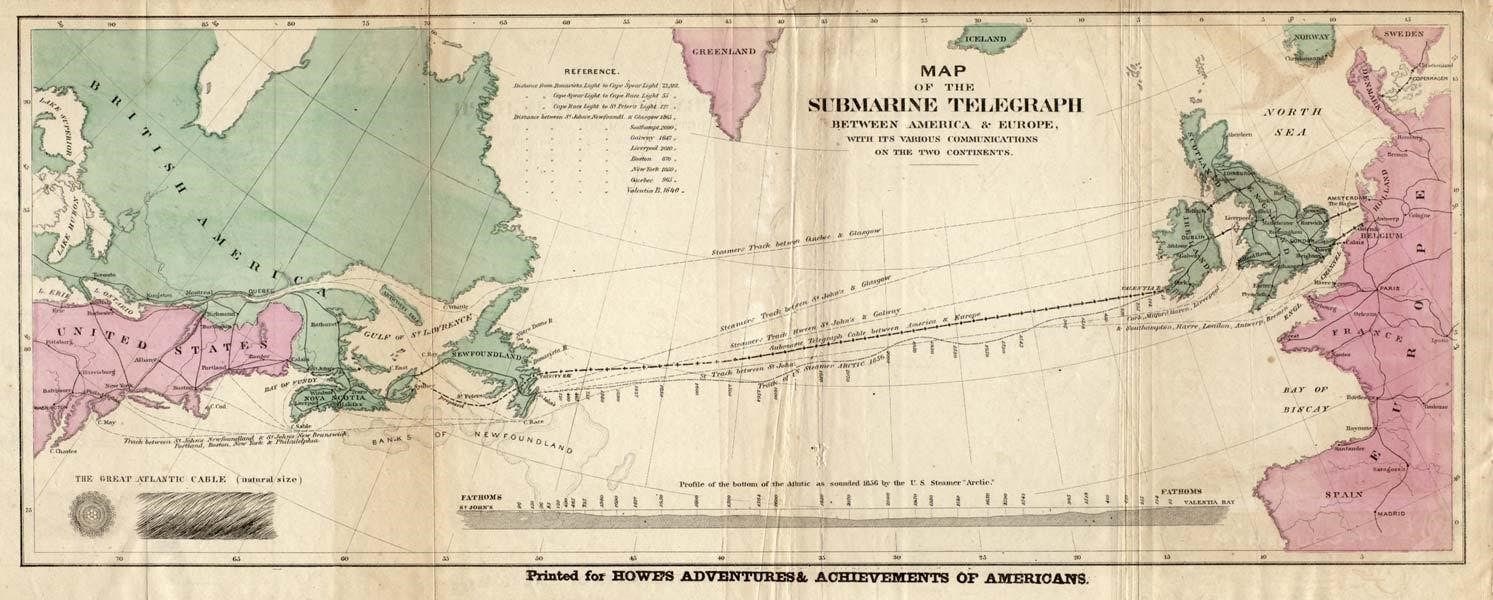
The first ever transatlantic telegraph cable was laid by wooden ships
21 of October of 2016
We press a button and the phone blinks. Less than a second later, the information we were looking for appears on the screen. In that fraction of time, a series of electrical impulses has crossed the planet to reach the server holding the information, while another has brought the requested information to us. Less than a second. 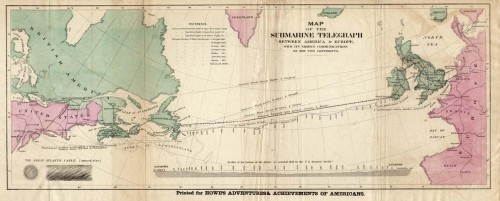 Hidden away in our modern laboratories, we study the world at a distance, forgetting the times when scientific progress signified adventure, physical risk and a constant fight against the elements. The times when wooden ships laid cables in the North Atlantic.
Hidden away in our modern laboratories, we study the world at a distance, forgetting the times when scientific progress signified adventure, physical risk and a constant fight against the elements. The times when wooden ships laid cables in the North Atlantic.
Which was the cutting edge technology in 1850?
From our perspective of practically instant communications, it is difficult to imagine what communications were like in 1850. Sending a letter from England to the Americas took more than a month, and cost a small fortune. If the winds were favourable, if the letter didn’t get lost, and if the person at the other end also had a small fortune at his or her disposal, a month later you might receive a reply. Sending information was a great achievement; holding a conversation something to celebrate. And so letters were copied, perhaps even twice, and sent on different ships: English, Portuguese, Spanish, even Italian. At times, the same letter arrived with several years’ difference, depending on the route travelled. 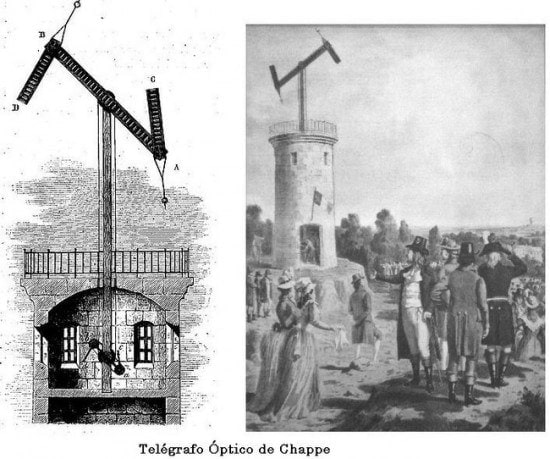
Chappe’s optical telegraph
Given this state of affairs, it was difficult for, say, England or Spain to maintain a stable government in their colonies or friendly nations, even if they were accessible by land. From around 1800 there became available a device known as the optic telegraph or semaphore: three bars or arms placed in an elevated position so that they were visible from several points. With a chain of these telegraphs, the first Internet in history was built: 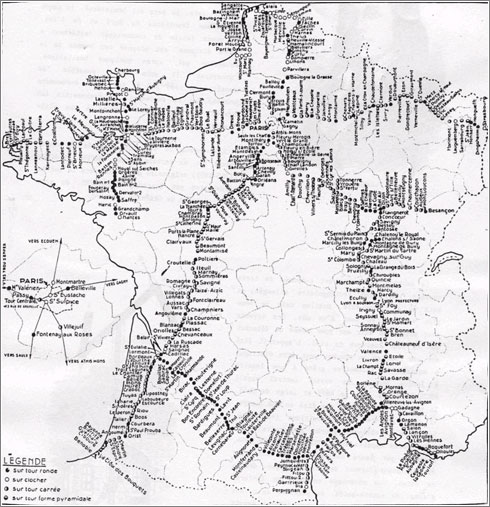
Semaphore network in France. Source: Microsiervos.
But communications which were easily intercepted, which transmitted only one symbol every 20 seconds and which required hundreds of steps between (for example) Paris and Madrid, were not really an option. When the information on something eventually reached its destination, either that something had already been solved, or there was no longer anything that could be done about it. If a colony was waiting for a reply from its relevant government, it would have to spend months doing nothing. Hearing the “news” was equally frustrating, for nothing could be done any more. Even breaking news was at least a month old! And so it came to be that when Queen Victoria inherited the throne of the British Empire in 1837, the speed of communications was just the same as it had been in the times of the Roman Empire, when Julius Caesar ruled . The electrical telegraph was urgently required: you simply couldn’t control a dozen colonies with letters sent in ships that took months to get there (if they ever arrived) or on horseback.
Julius Caesar and Queen Victoria. Two thousand years of history between them, yet marine and communications technology had barely changed.
In Europe, W.F. Cooke picked up on this need and in 1836 gave up his job as a cook, studied physics, and patented his first electrical telegraph with the help of physics professor Charles Wheatstone. Something similar happened in America, where Samuel Morse, aided by Joseph Henry, patented his own telegraph. Samuel Morse quickly expanded the railway throughout America , and Cooke, for his part, helped it advance across Europe. By 1850, almost the whole of Europe and North America were covered. There remained the slight problem of that small expanse of water called the Atlantic, which divided the world in two. Now all that was needed was ships to lay underwater cables, the Victorian equivalent of the Apollo project.
What were the (wooden) ships of 1850 like?
Shipbuilding technology had not improved much since the Egyptians stopped using flexible bamboo in favour of durable wood, around 3000 B.C. Five millennia during which the planks of wood used, due to the fact that they were relatively short, resulted in structurally weak ships, causing deformation and eventually collapse. The largest ships tended to grow a belly or become wider in the middle, and the deck tended to curve inwards, making the tips of the masts move closer together. To avoid this, the Egyptians used a long, stiff reed running from bow to stern; the Romans used a large horizontal tree-trunk instead which they called the “supporting beam”. A beam (or should we say a whole tree) was what the first ships to throw thousands of kilometres of telegraph cable overboard needed two thousand years later. Without such beam, they would never have been able to carry the massive weight required for laying the first transatlantic communications cable.
What was the first oceanic cable in history?
In 1853, stirred on by echoes of the technological advances that were happening on other continents, a business man by the name of Cyrus West Field attempted to lay a cable across the North Atlantic, starting in Newfoundland. The result: seven dead and three mutinied crew members (from a total of ten), 60km of cable lost, and a bankrupt company. Attempts in inland seas (the Irish Sea, the North Sea, the Baltic and the Mediterranean) were somewhat easier, and by 1854 they were all crossed by cables. Thousands of kilometres of cable, in fact, following in the wake of the small English tugboat Goliath which crossed the Dover channel on 28th August 1850 to lay the first ever 38 km of cable (though it was to be cut only a few hours later by a fisherman who thought he had discovered a new type of metallic marine creature). 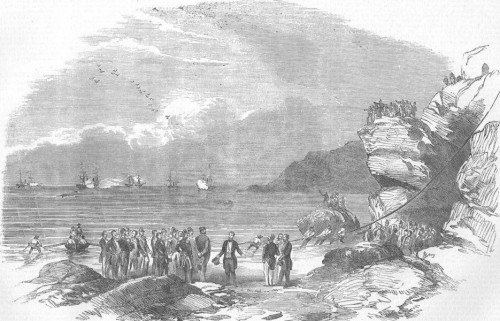
Print of the coast of La Spezia (then Spezzia) showing the laying of a cable in the Mediterranean on 19th August 1954. Source: The Illustrated London News
These cables lasted an average of a few weeks before they were cut by an anchor or picked up by accident in a fishing net, or they simply stopped working for unknown reasons. But Field was not to be stopped, either by reason of being bankrupt or by his now rather questionable reputation, and by 1856 he had managed to obtain 3,500 km of cable from the British government and support from warships Agamemnon and Niagara, with the intention of laying the cable from Valentia in Ireland.
“And what will happen if you are unsuccessful? If you make an attempt and fail, if the cable is lost at sea, what then?” enquired Lord Clarendon, the then Foreign Affairs Minister for the British Government. To which Field replied: “Charge it to profit and loss, then put me to work on a new attempt.”
First attempt. 6th August 1857
No sooner said than done. Several months later, Field again asked for funding for a new cable, after losing the first 539 km ever to be laid in the North Atlantic. This was the distance from the coast at which the cable snapped, and it proved impossible to retrieve it from the ocean floor. It was not until a year –and many investments– later, that warships Agamemnon and Niagara were commissioned once again. 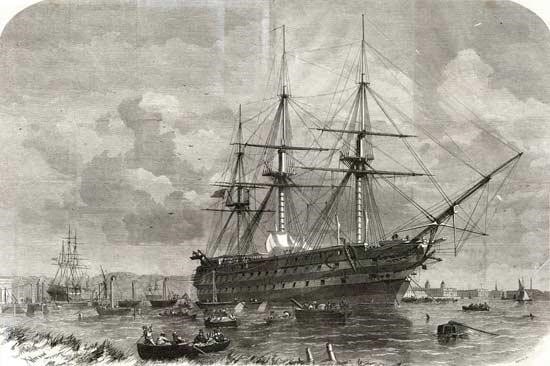
Agamemnon, a warship launched in 1781 by the Royal British Navy. Its 91 cannons and a large number of inner partitions and load had to be taken out to accommodate close to 800 tonnes of cable, with several hundred more on deck . Print from 1857, when loaded with the cable. Source: The Story of Subsea Telecommunications & its Association with Enderby House
Second attempt. 26th June 1858
In the spring of 1858, both ships started off from the mid-Atlantic, each carrying one end of the cable, heading for Newfoundland (Canada) and Valentia. Just a few hours after splicing the cable together between the two ships, the fiercest storm ever registered struck. It lasted for a week, and almost caused both ships to capsize. They managed to survive the storm, but just a few hours after resuming the laying of the cable, communications through the cable between the two ships ceased. So they both returned to the starting point, only to find that they were each still holding their end of the cable: it must have snapped on the ocean bed.
Third attempt. 26th June 1858
So they dropped both ends and started again the same day. But this third attempt ended in disaster once more. The cables again snapped, this time after the Agamemnon had covered 320 km. The crew was exhausted, provisions were running low, and they had made practically no progress. Both ships returned to port. To get food (and more cable). Fourth attempt. 29th July 1858 Field didn’t give up, and secured a fourth attempt on the morning of 28th July 1858. That same morning, just minutes after splicing the cable together mid-ocean between the Agamemnon and the Niagara, a large group of whales was spotted. To the crew’s surprise, one of the whales swam right up to the cable to see what it was. Luckily, it left again, showing little interest. 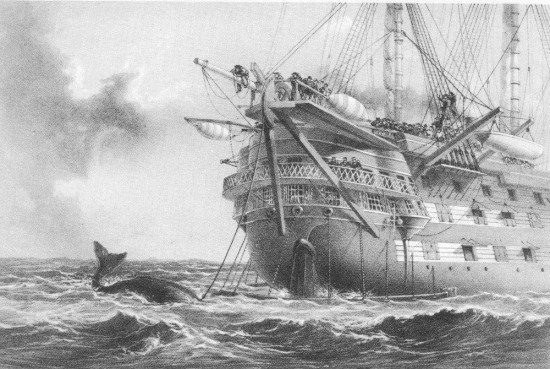
Print of 29th July 1858. A whale swims up to inspect the cable joining the Agamemnon and the Niagara. Source: Wikipedia.
This fourth attempt was not without danger. The Agamemnon almost sank three times, the cable snapped several times, and contact between the two ships was lost at times for up to eight hours. Tensions on the ships were running so high that some sailors suffered psychotic episodes and had to be arrested. But both ships managed to complete their trip with their end of the cable. On 5th August 1858 both ships reached harbour, the last connections were made, and the two continents were able to listen to one another.
The world became one, at least for a month
The first message did not arrive until almost a week later, for complicated adjustments had to be made at both ends, the cable was of extremely poor quality, and the engineers in charge on either side wanted to connect their own patented devices, not realising that the cable would perhaps not support their inventions. However, on 16th August a message was sent by Queen Victoria to President Buchanan: 99 words, taking 16.5 hours to send. This paragraph has 55. The citizens of New York were so excited over the whole thing that they let off fireworks which set the Town Hall alight and almost burnt down the whole structure. A few weeks later, on 1st September 1858, New York welcomed Cyrus Field with a huge ovation and a parade. As (bad) luck would have it, that same day, when the cleaning squads were tidying up after the celebrations, the cable stopped working after less than a month in use. No more messages were ever sent, and eight years would go by before the next attempt. But it no longer mattered. From that moment on, everyone knew that it was possible for the world to become one, and no engineer will ever forget the exploits of those who went before them. There is always one working and searching for a project that will benefit mankind as a whole. Some now look upwards into space, wondering whether the next Field has already designed a project, or who will build the Agamemnons and Niagaras that will take us up there.







There are no comments yet